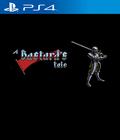We've entered a renaissance of sorts where difficult games are praised and sought out instead of avoided. Games like the Ninja Gaiden reboot and Bloodbourne aren't necessarily for everyone, but the challenge they provide is satisfying. Difficult games like that are often loved because death occurs often but fairly. A Bastard's Tale tries really hard to capture that in 2-D sprites instead of 3-D polygons. Despite the obvious care put into it, the game just doesn't hit the mark.
One of the first things you'll notice is that A Bastard's Tale does away with narrative altogether. There's no backstory to start things off, no cut scenes to tie in your motivations for your actions, and nothing else to suggest why you're facing off against enemies. You simply walk, defend, kill, and repeat.
For a protagonist in a side-scrolling action game, your hero is pretty poor in the agility department. You walk along each stage at a plodding pace without the chance to get in a small dash or get a temporary speed boost. You can't jump, and while you can do a defensive roll, you can only roll backward instead of forward. At least your attacks are strong, but each blow you attempt requires a good amount of wind-up time before it's delivered, which is a big difference from the immediacy of your blocking ability.
The game's main focus is on combat, which has some depth even with the lack of a third dimension. Your attacks come in three forms: an overhead chop, a horizontal slash from left to right, and a horizontal slash from right to left. Conversely, your blocks take care of both overhead chops and horizontal swings from either direction, provided you choose the correct direction to block from.
With that system in place, A Bastard's Tale throws a wide variety of enemies at you to test your mettle. The villagers start off as good training partners, and the rushing bulls teach you that some enemies can only fall with well-timed strikes, since you can't block their attacks. It doesn't take long before the first boss appears, a black knight that takes several strikes to kill. From there, the enemies get more varied as you encounter more armored soldiers, spearmen and cavalry. Things get trickier with crows and sorcerers, who teach you about patience and not striking blindly at anything that moves.
Like the games that serve as its inspiration, it's vital to know when to strike and being patient enough for that opportunity. Enemies barely take rest periods, and they won't attack unless you're within range. You can get lucky a few times and strike first, but your time with most of the enemies will be spent learning how to block and when to sneak in a hit before blocking again. Some of the other enemies, like the spearmen and cavalry, are more interesting since the type of strike you perform determines whether you can initiate a killing blow. It becomes a brutal puzzle of sorts.
It is painful, then, to see that the deep combat system is undone by various small things that drag down the quality. The differences between some of the tells can be very minute, so the difference between a block on the right and a block on the left might as well not be there. There is a counter that keeps track of how many times you died, but it might as well keep track of how many times you guessed incorrectly, since you'll often fall due to unclear attack readings. It also doesn't help that hitting enemies with energy meters results in no feedback as to whether the strike went through or was blocked. Finally, it would've been nice if the game allowed you to configure your controls, since it's more comfortable to use a d-pad than the analog stick in a strictly 2-D title.
Once you get the basics down, you'll find out that there's not much to A Bastard's Tale. Take away the level restarts due to death, and you'll find that the campaign consists of five short levels that end pretty quickly after a few enemy encounters. You can replay the campaign from that point to get different enemy patterns per stage, but there's nothing else gained from it. Beyond that, you have an endless mode that sees how far you can go and how many enemies you can kill before succumbing to death. This is a short game that only seems long due to its difficulty level.
The overall presentation may remind you of the old Commodore Amiga system. The environments are lush with loads of good details and animations. The multi-layered parallax scrolling can be a bit much depending on the environment, but it still remains an impressive trick for those who grew up with pixels as the norm. The characters are good except for the difficult-to-read attack tells mentioned earlier, while some of the other attacks look odd since the upper half of the body has fluid animation while the lower half is stiff. As for audio, the effects are fine and the music is decent. You will have to crank it up in the options, since the default level is barely audible.
A Bastard's Tale is the kind of game you want to like. The level of challenge is very high, and those with an extreme amount of patience will get the most out of it. However, the combat is rough and unfair most of the time, and your lack of agility can make defeat sting much more. It is short and cheap, but unless you're a masochist, you're better off giving passing on this one.
Score: 5.0/10
More articles about A Bastard's Tale











 A Bastard's Tale is a brutally hard game about parrying, attacking, and overcoming difficult foes.
A Bastard's Tale is a brutally hard game about parrying, attacking, and overcoming difficult foes.






